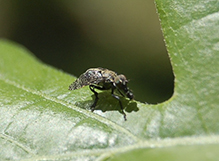dancing kiss fly
(Platystoma seminationis)
Conservation • Description • Habitat • Ecology • Distribution • Taxonomy
|
|
||||||||||||||
Description |
Dancing kiss fly is an exotic signal fly. It is native to Europe and has been introduced into the United States. The first North American record is in Chicago in 2003. From that location it has spread throughout northeastern Illinois and into southeastern Wisconsin, and it has jumped to the Twin Cities metro area in Minnesota. Adults are found from May to October, low in vegetation, at forest edges and in hedges. They feed on flower nectar and pollen. Larvae probably feed on dead plant or animal matter, like most signal flies. Adults are 3⁄16″ to ¼″ (5 to 7 mm) in length. The head is large, higher than long, and yellowish-brown to blackish-brown. There are two large compound eyes at the side of the head and three small simple eyes (ocelli) in a triangle at the top of the head. The compound eyes are reddish-brown. They do not meet at the top of the head in either sex. The area between the ocelli (ocellar triangle) is black. There are no bristles on the front of the head. The upper face, corresponding to the forehead (frons) is black. The face is black and shiny with silvery-white hairs. There is a line of dense hairs on the orbits around the compound eyes, and a line of minute hairs from the ocellar triangle down the frons. The antennae are short and have three segments. The second segment does not have a longitudinal groove (suture). The third segment is rounded at the tip and has a short, forward-pointing bristle (arista) on the upper side. The collection of protruding mouthparts (proboscis) is reddish-brown and large. This is the feature that gives the family Platystomatidae, meaning “big mouth”, its common name. The thorax is black and is scattered with areas of dense yellowish-brown hairs. It appears grayish-brown from a distance, mottled when seen close up. On the front of the thorax there are no propleural bristles, and on the underside there are no sternopleural bristles. The abdomen is black and uniformly scattered with areas of dense white hairs. It appears grayish from a distance, mottled when seen close up. The legs are mostly black. On the middle legs there is a row of black spines on the underside of the fourth segment (tibia). The last part of the leg, corresponding to the foot (tarsus) has five segments. On all legs the tarsi have yellowish areas and have short black spines on the underside. The wings are dark brown to black with scattered, whitish, translucent (hyaline) areas, making them appear mottled. The anal cell is rounded at the tip. The vein on the leading edge of the wing (costal vein) is not broken near the end of the subcostal vein. |
Size |
3⁄16″ to ¼″ (5 to 7 mm) |
Similar Species |
Habitat |
Forest edges, hedges |
Ecology |
Season |
May to October |
Behavior |
|
Life Cycle |
|
Larva Food |
Dead plant or animal matter (probably) |
Adult Food |
Flower nectar and pollen |
Distribution |
||
|
Sources |
|
| 5/31/2024 | ||
Occurrence |
||
Rare |
||
Taxonomy |
|
Order |
|
Suborder |
Brachycera |
Infraorder |
Cyclorrhapha |
Zoosection |
Schizophora |
Zoosubsection |
Acalyptratae (acalyptrate flies) |
Superfamily |
Tephritoidea (fruit, signal, and picture-winged flies) |
Family |
Platystomatidae (signal flies) |
Subfamily |
Platystomatinae |
Genus |
Platystoma |
Subordinate Taxa |
|
dancing kiss fly (Platystoma seminationis angustipenne) dancing kiss fly (Platystoma seminationis bisetum) dancing kiss fly (Platystoma seminationis frauenfeldi) dancing kiss fly (Platystoma seminationis rufimanum) dancing kiss fly (Platystoma seminationis seminationis) |
|
Synonyms |
|
Musca seminationis Platystoma seminatione Platystoma valachiae |
|
Common Names |
|
dancing kiss fly speckled semaphor fly |
|
Glossary
Frons
The upper front part of an insect’s face, roughly corresponding to the forehead.
Ocellus
Simple eye; an eye with a single lens. Plural: ocelli.
Proboscis
The tube-like protruding mouthpart(s) of a sucking insect.
Tarsus
On insects, the last two to five subdivisions of the leg, attached to the tibia; the foot. On spiders, the last segment of the leg. Plural: tarsi.
Tibia
The fourth segment of an insect leg, after the femur and before the tarsus (foot). The fifth segment of a spider leg or palp. Plural: tibiae.
Visitor Photos |
||
Share your photo of this insect. |
||
This button not working for you? |
||
vicki Bonk |
||
 |
|
|
| Mating |
|
|
Bob Payton |
||
 |
|
|
on Bur Oak Leaf, |
||
MinnesotaSeasons.com Photos |
||
|
||
|
||

Slideshows |
Platystoma seminationis |

|
Platystoma seminationis |

|
About
Platystoma seminationis |

Visitor Videos |
||
Share your video of this insect. |
||
This button not working for you? |
||
|
Other Videos |
||
Platystoma seminationis |
About
Jun 8, 2013 |
Platystoma seminationis - signalna muha |
About
Jun 3, 2018 |
Fliege Platystoma Seminationis |
About
Oct 7, 2012 Fliege Platystoma Seminationis |

Visitor Sightings |
||
Report a sighting of this insect. |
||
This button not working for you? |
||
vicki Bonk |
Location: Hennepin County Mating |
 |
Bob Payton |
Location: South Minneapolis, Howe neighborhood on Bur Oak Leaf, |
 |
MinnesotaSeasons.com Sightings |
||
|

Created: 12/8/2022 Last Updated: © MinnesotaSeasons.com. All rights reserved. |
